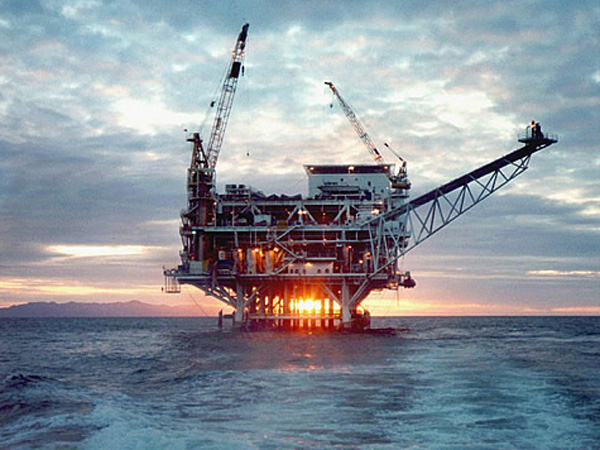Why Is Offshore Drilling So Dangerous?

The Gulf of Mexico oil leak has fired up arguments against offshore drilling. After decades of heated debate, this incident shed light on its dangers and impact on the environment.
Offshore drilling, the process of extracting oil and gas resources from underwater locations, including lakes, has been conducted at increasingly deeper and farther off shore sites in recent years, as shallow fossil fuel reserves and near-shore drilling locations have become exhausted.
But with deeper drilling depths comes increased danger including higher risks of accidents, spills and fires, according to the National Oceanic and Atmospheric Administration (NOAA).
"Big Oil has perpetuated a dangerous myth that coastline drilling is a completely safe endeavor, but accidents like this are a sober reminder just how far that is from the truth," said Democratic Senator Robert Menendez in a press statement. "The fact is that 509 oil rig fires have broken out in the Gulf of Mexico since 2006."
Why is it so dangerous?
One reason for this increased danger is the complex equipment needed to drill at such depths. As offshore drilling continues to be pushed to new depths, with oil companies continuously drilling in deeper waters and penetrating further underground, the technology needed to achieve these feats is extremely complex and not entirely invincible.
This is a pretty frigging complex system, said Robert Bea, an engineering professor at the University of California, Berkeley, in an interview with Yale Environment 360, a publication of Yale University. You've got equipment and steel strung out over a long piece of geography starting at surface and terminating at 18,000 feet below the sea floor. So it has many potential weak points. Just as Katrina's storm surge found weaknesses in those piles of dirt the levees gas likes to find weakness in anything we connect to that source.
Sign up for the Live Science daily newsletter now
Get the world’s most fascinating discoveries delivered straight to your inbox.
Another reason for the danger is the harsh offshore environments that pose engineering challenges to offshore drilling equipment. Severe weather, ice and storms pose risks to the functionality of the rigs, and their distance from land make it harder for additional rescue personnel to promptly reach the areas in emergency situations.
The inexperience of oil companies at operating at these depths is a third issue.
BP Chief Operating Officer Doug Suttles acknowledged that many of his company's efforts to stop the oil leak failed because they had never had to plug a well at such depths and were therefore unprepared for the conditions that foiled their attempts including ice formation inside of the original containment dome due to freezing deep water temperatures.
The Deepwater Horizon oil rig had drilled the world's deepest offshore well before it exploded and sank on April 20, according to the U.S. Department of Energy (DOE). The Deepwater Horizon drilled the well to 35,055 feet (10 kilometers) or more than six miles, operating in 4,130 feet (1 kilometer) of water, according to BP.
The first rig to attempt such depths, the well's pipes had been cemented for only 20 hours before the rig went up in flames, according to oil services contractor Halliburton Inc.
"The bottom line is that when you drill for oil, there is always a risk that not only puts lives on the line, but a risk that puts miles of coastline and the economy on the line as well," Menendez said.
Drilling plans and drilling bans
In the beginning of May, Chevron Canada started drilling what could now become the world's deepest offshore oil well, and planned to reach a depth of one kilometer deeper than the well drilled by the Deepwater Horizon rig. However, the drilling project was put on hold by Newfoundland Offshore Petroleum Board until the company can provide evidence that it has taken sufficient preventative measures against oil spills.
On March 31, President Obama had announced the end of a decades-old ban on oil and gas drilling along much of the U.S. Atlantic coast and in northern Alaska. The lifted ban was aimed at increasing the United States' energy independence and reducing foreign imports so that it would not need to rely so heavily on other countries for energy supplies. The U.S. Atlantic coast could hold as much as 37 trillion cubic feet of gas and 4 billion barrels of oil, the U.S. Geological Survey estimates.
But less than a month later, the BP-leased Deepwater Horizon rig sank about 50 miles (80 kilometers) southeast of Venice, Louisiana.
President Obama recently announced during his weekly address that no permits for drilling new deepwater wells will be issued until a 30-day safety and environmental review of all deepwater operations in the Gulf of Mexico has been completed. Representing 30 percent of our oil production, the Gulf of Mexico plays an important role in the future of the country's energy production, said Obama.
"But we can only pursue offshore oil drilling if we have assurances that a disaster like the BP oil spill will not happen again," Obama added.
White House officials said that Obama is considering extending the hold on permits for six more months and may delay or cancel specific drilling projects off the coasts of Alaska and Virginia and in the western Gulf of Mexico, according to the New York Times.
Part of what is happening in the Gulf is that oil companies are drilling a mile under water before they hit ground, and a mile below that before they hit oil, Obama said. With the increased risks, the increased costs, it gives you a sense of where we're going."









